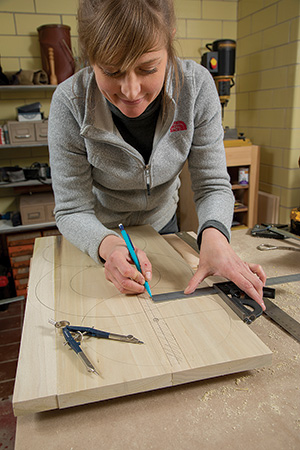
How can I tell if my squares are really 90 degrees square? I have a speed square, a try square and a construction square. Each have their own version of what is square and none of them are exactly the same. The last time I was at one of the big-box stores, I compared squares and only three out of 10 were the same. When you go to the store to buy a square, how do you pick the one that is really square? There’s got to be a way to get a true square (without spending a fortune).
Michael Dresdner: Here’s two simple ways to check a square, and another to true an inexpensive square.
Take a piece of close grained wood, such as maple, with one straight edge, and lay the square with its handle on the edge, and the blade on the face of the wood. Using a very sharp pencil, draw a line along the length of the square’s blade. Now flip the square over, so the other side of the blade is up, and draw another line right next to the first one. If the two lines are perfectly parallel, your square is fine. If the lines diverge or converge, it is not.
For an even easier way, you can check it by laying the inside edge of the square along a cheap, plastic drafting square, which, oddly enough, is pretty much always accurate.
To true a combination (adjustable) square, loosen the knurled knob, remove the blade, then remove the knob and hook. Using an auger file or a flat edge joint file, remove a small amount of material at the bottom of the blade slot on the side that is high. In other words, if when you lay the square on a plastic drafting triangle there is a gap at the tip of the blade, remove material from the front edge of the slot. If the gap is at the back of the blade, near the handle, remove metal from the back of the slot. With a few strokes of the file, you should quickly get a perfectly true square, even if you start with a cheap tool.
Rob Johnstone: There are several cool techniques from my Jr. High geometry class that would help you test for square. But those classes were so long ago that slide rules were just being introduced as a “modern miracle”. Accuracy is a moving target in the woodworking world. What is square enough for laying out floor joist and stud walls is not sufficent for cabinetry. In the same way, while measuring to 1/16 of an inch will get you by in most cabinetry situations & it is too gross of a measure for work such as luthiery. (I’ve laid measuring tapes next to each other and observed that their scales ran “out of true to each other” & it disturbed me.) With that said, truing a square as Michael described above will get you a square that will do everything that you need. Once you get a “true” square, use it to adjust your other squares (you can run a plastic speed square over a jointer to fix it up, and it will hold true ever after).





